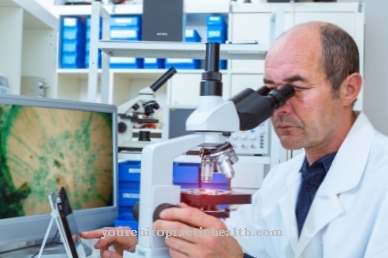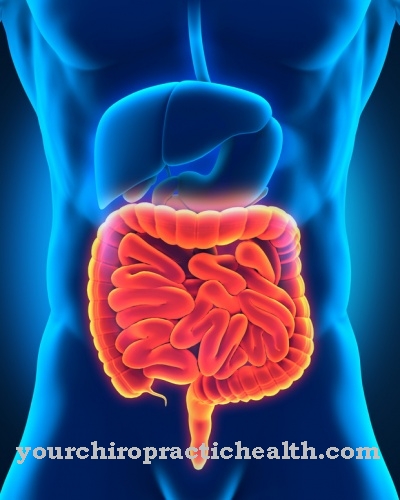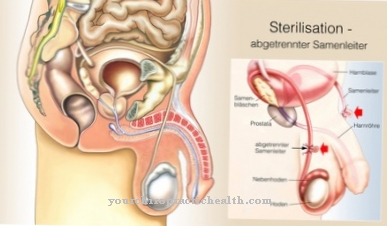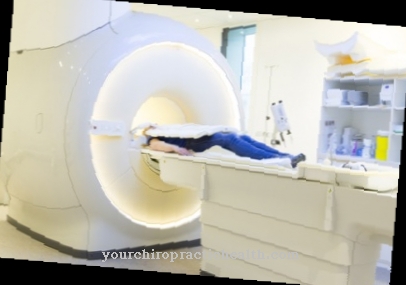The Fluorescence tomography is an imaging technique that is mainly used in in vivo diagnostics. It is based on the use of fluorescent dyes that serve as biomarkers. Today the procedure is mostly used in research or in prenatal studies.
What is fluorescence tomography?

Fluorescence tomography records and quantifies the three-dimensional distribution of fluorescent biomarkers in biological tissues. The so-called fluorophores, i.e. the fluorescent substances, initially absorb electromagnetic radiation in the near infrared range. Then they emit radiation again in a slightly lower energy state. This behavior of the biomolecules is called fluorescence.
The absorption and emission take place in the wavelength range between 700 - 900 nm of the electromagnetic spectrum. Polymethines are mostly used as fluorophores. These are dyes that have conjugating electron pairs in the molecule and are therefore able to absorb photons to excite the electrons. This energy is released again with light emission and heat generation.
While the fluorescent dye is glowing, its distribution in the body can be visualized. Like contrast media, fluorophores are used in other imaging procedures. They can be administered intravenously or orally, depending on the area of application. Fluorescence tomography is also suitable for use in molecular imaging.
Function, effect & goals
Fluorescence tomography is usually used in the near-infrared range because the short-wave infrared light can easily pass through the body tissue. Only water and hemoglobin are able to absorb radiation in this wavelength range. In a typical tissue, hemoglobin is responsible for approximately 34 to 64 percent of absorption. It is therefore the determining factor for this procedure.
There is a spectral window in the range from 700 to 900 nanometers. The radiation from the fluorescent dyes is also in this wavelength range. Therefore, the short-wave infrared light can penetrate biological tissue well. The residual absorption and scattering of the radiation are limiting factors of the procedure, so that its application remains limited to small tissue volumes. Fluorescent dyes from the group of polymethines are mainly used as fluorophores today. However, since these dyes are slowly destroyed on exposure, their use is considerably limited. Quantum dots made from semiconductor materials are an alternative.
These are nanobodies, but they can contain selenium, arsenic and cadmium, so that their use in humans must be excluded in principle. Proteins, oligonucleotides or peptides act as ligands for conjugation with the fluorescent dyes. In exceptional cases, non-conjugated fluorescent dyes are also used. The fluorescent dye "indocyanine green" has been used as a contrast medium in angiography in humans since 1959. Conjugated fluorescence biomarkers are currently not approved for humans. For application research for fluorescence tomography only animal experiments are carried out today.
The fluorescence biomarker is applied intravenously and the dye distribution and its accumulation in the tissue to be examined are then examined in a time-resolved manner. The animal's body surface is scanned with an NIR laser. A camera records the radiation emitted by the fluorescence biomarker and combines the images into a 3D film. In this way, the path of the biomarkers can be followed. At the same time, the volume of the marked tissue can also be recorded so that it is possible to estimate whether it is possibly tumor tissue. Today fluorescence tomography is used in many ways in preclinical studies. Intensive work is also being carried out on possible uses in human diagnostics.
Research plays a prominent role here for its application in cancer diagnostics, especially for breast cancer. It is assumed that fluorescence mammography has the potential for an inexpensive and rapid screening method for breast cancer. As early as 2000, Schering AG presented a modified indocyanine green as a contrast medium for this process. However, it has not yet been approved. An application to control lymph flow is also discussed. Another potential area of application would be the use of the method for risk assessment in cancer patients. Fluorescence tomography also has great potential for the early detection of rheumatoid arthritis.
Risks, side effects & dangers
Fluorescence tomography has several advantages over some other imaging techniques. It is a highly sensitive procedure in which even the smallest amounts of fluorophore are sufficient for imaging. Their sensitivity can be compared with the nuclear medicine procedures PET (positron emission tomography) and SPECT (single photon emission computed tomography).
In this respect, it is even superior to MRI (magnetic resonance imaging). Furthermore, fluorescence tomography is a very inexpensive method. This applies to the equipment investment and operation as well as the implementation of the investigation. In addition, there is no radiation exposure. However, the disadvantage is that the high scattering losses drastically decrease the spatial resolution with increasing body depth. Therefore only small tissue surfaces can be examined. In humans, the internal organs cannot be represented well at the moment. However, there are attempts to limit the scattering effects by developing time-selective methods.
The heavily scattered photons are separated from the only slightly scattered photons. This process is not yet fully developed. There is also a need for further research in the development of a suitable fluorescence biomarker. The previous fluorescence biomarkers are not approved for humans. The dyes currently used are broken down by the action of light, which means a considerable disadvantage for their use. Possible alternatives are so-called quantum dots made of semiconductor materials. However, due to their content of toxic substances such as cadmium or arsenic, they are not suitable for use in in vivo diagnostics in humans.













.jpg)

.jpg)
.jpg)











.jpg)